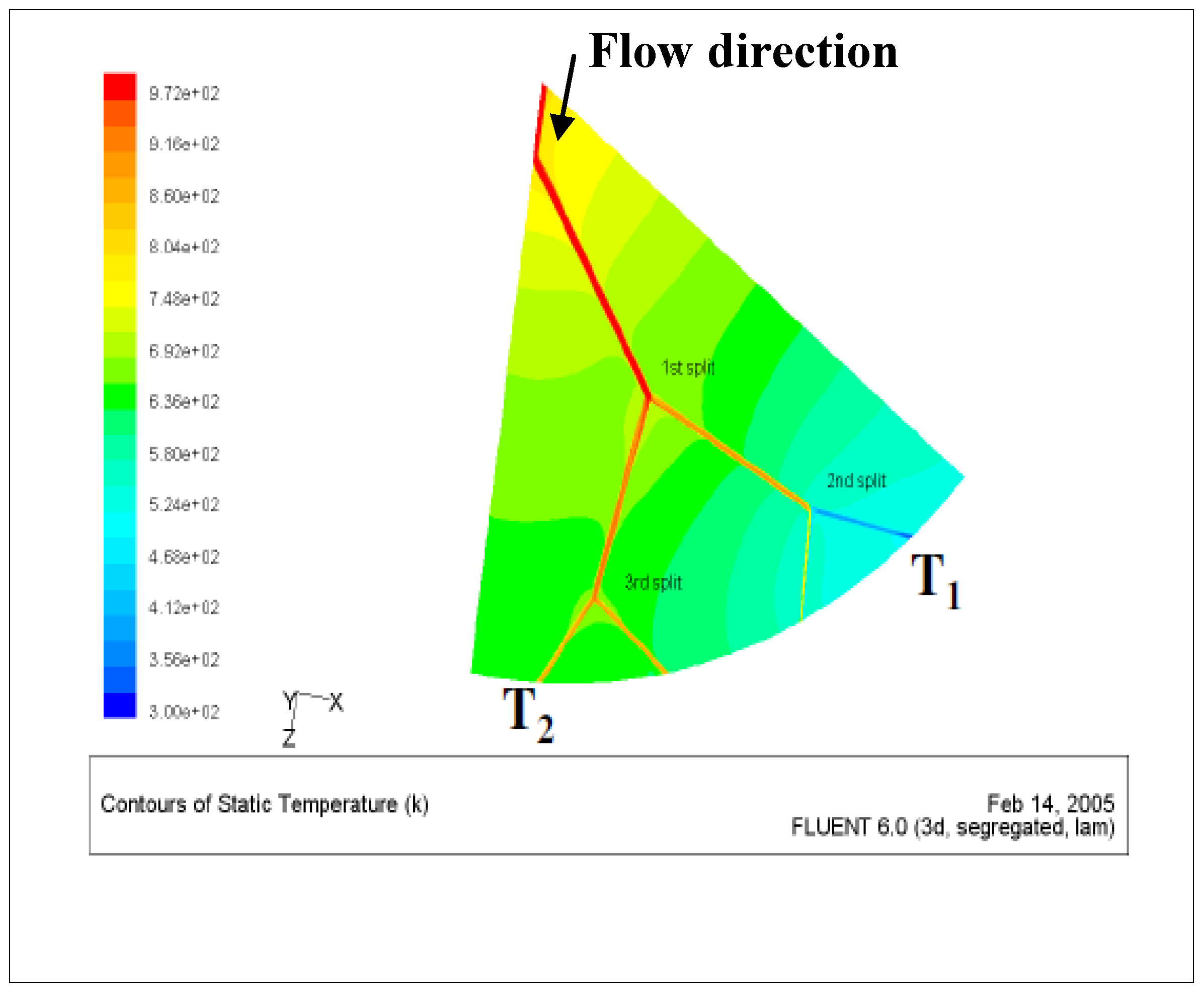Entropy Generation Minima in Different Configurations of the Branching of a Fluid-Carrying Pipe in Laminar Isothermal Flow
Abstract
:1. Introduction
- (a)
- In natural flow systems (both inert and biological structures), why does a flow bifurcation (of the type shown in Figure 1) occur?
- (b)
- In man-made applications, is there an “optimal” bifurcation pattern for a given design goal, and how can it be identified?
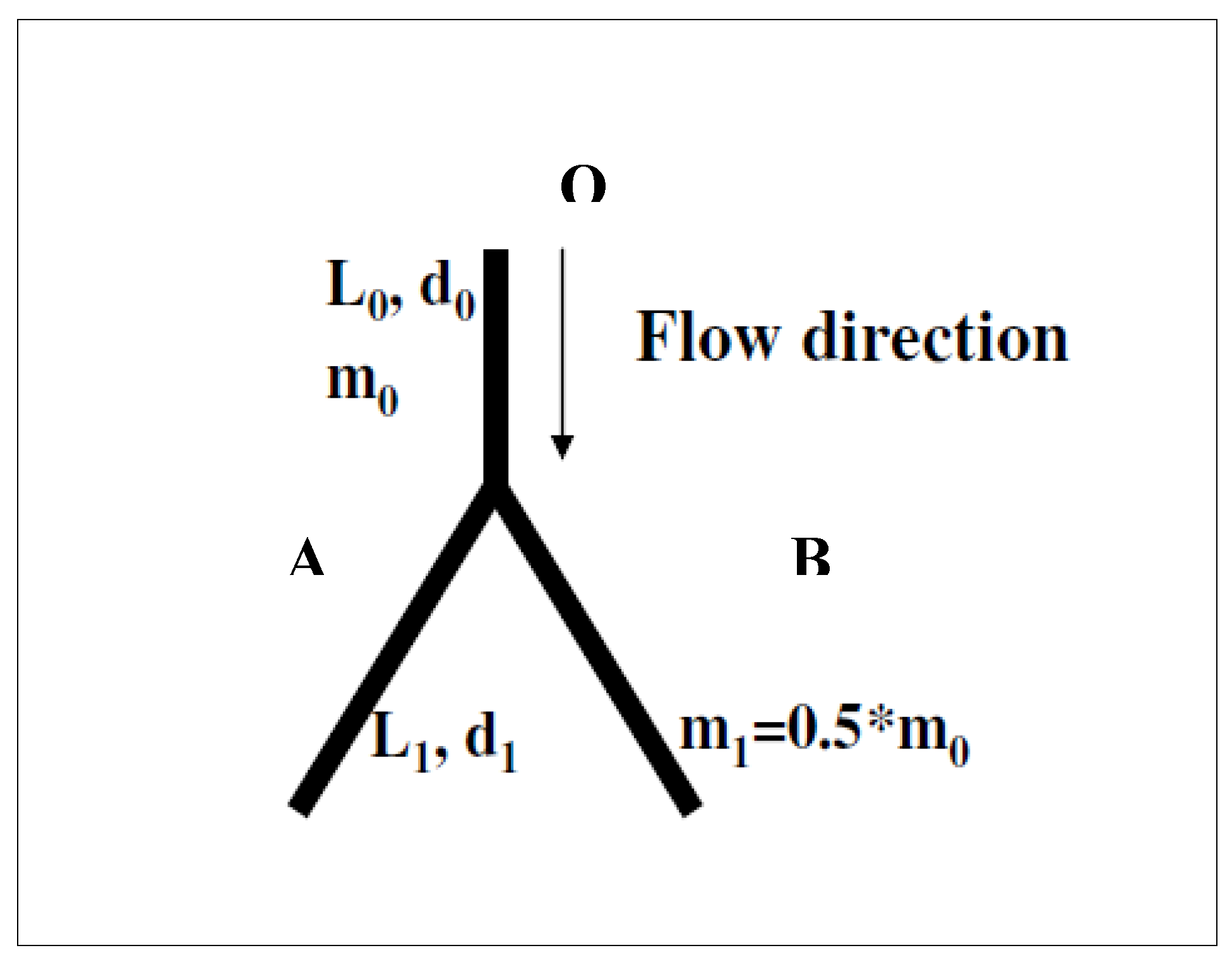
2. The Entropy Generation Rate in a Channel
2.1. The standard derivation of the velocity profile in plane Poiseuille flow
2.2. Alternative derivation of the velocity profile of plane Poiseuille flow
3. The Entropy Generation Rate in a Simple Bifurcation


4. Results and Discussion
- (1)
- The Reynolds number remains constant over the entire fluid path: Re0 = Re1. This defines a diameter ratio δ = r1/r0 = 0.5;
- (2)
- The velocity remains constant over the entire fluid path: U0 = U1. This defines a diameter ratio δ = r1/r0 = 0.707;
- (3)
- The volume occupied by the fluid in the unsplit portion is equal to that occupied by the two bifurcated branches. This defines a diameter ratio δ = r1/r0 = .
4.1. The ideal case, no bifurcation losses
- (a)
- For all cases, the entropy generation rate strongly depends on the aspect ratio ar of the domain in which the bifurcation occurs. With the geometry selected here, higher ar lead — for the same splitting ratio λ — to a longer bifurcated stretch, of smaller diameter and therefore with higher losses;
- (b)
- The constant velocity case displays a lower entropy generation rate than the constant Re case for any bifurcation length. This is due to the fact that the mass conservation constraint imposes a higher diameter ratio on the split portions of the tubes that are therefore affected by a lower dissipation rate;
- (c)
- The constant fluid volume configurations display extremely high entropy generation rates for low splitting ratios, but are the least dissipative structure for high. However, the minimum dissipation is attained with diameter ratios near unity: the short bifurcations have a larger diameter than the initial portion of the channel, and the velocities are under the specified mass flow rate constraint correspondingly lower.
- (d)
- For each physical situation (constant Re, constant U, and constant Vfluid) there is indeed a rather well identifiable “optimal” configuration for each aspect ratio that displays a minimum value of the entropy generation rate. The exact values are reported in Table 1.
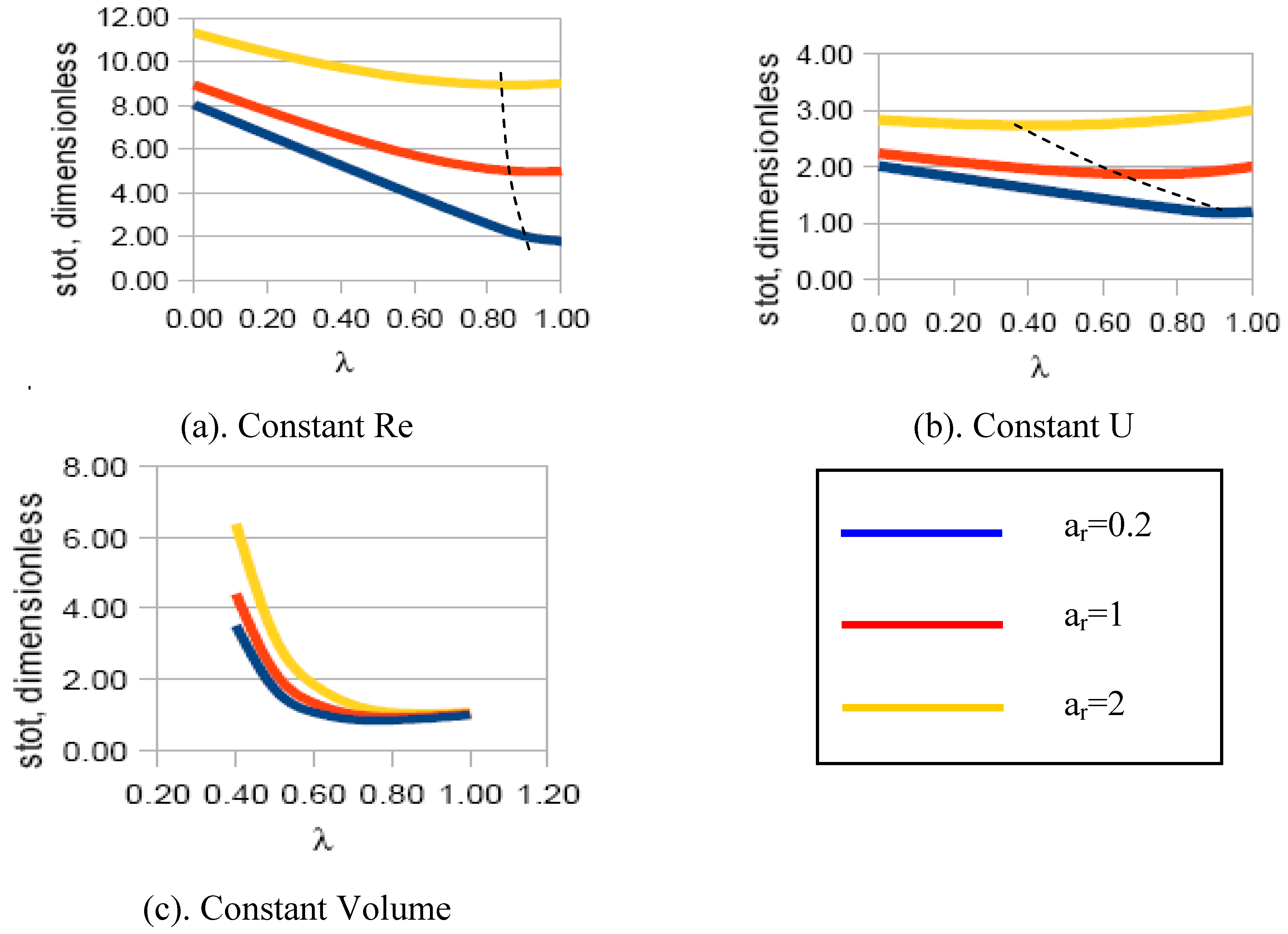
- (1)
- Use of an “optimal” diameter ratio (the basic assumption of all allometric models) is avoided, since this parameter is uniquely specified once the physical flow type has been assigned (constant Re, constant U, constant fluid volume);
- (2)
- A suitable physical correlation is introduced in the above mentioned models to link the “optimal” splitting ratio λ to the diameter ratio δ. in such a way that the minimum entropy generation — which is the most reasonable indicator of “optimal performance” — is at least one of the components of the objective function;
- (3)
| Case: Re0 = Re1 | δ =r1/r0 | Minimum | |
| ar = 0.2 | 0.5 | 1 | 1.80 |
| ar = 1 | 0.5 | 0.9 | 4.98 |
| ar = 2 | 0.5 | 0.9 | 8.94 |
| Case: U0 = U1 | δ =r1/r0 | Minimum | |
| ar = 0.2 | 0.707 | 0.9 | 1.18 |
| ar = 1 | 0.707 | 0.7 | 1.87 |
| ar = 2 | 0.707 | 0.4 | 2.73 |
| Case: V0 = 2V1 | δ =r1/r0 | Minimum | |
| ar = 0.2 | 1.15 | 0.8 | 0.86 |
| ar = 1 | 1.15 | 0.8 | 0.95 |
| ar = 2 | 1.36 | 0.9 | 1.05 |
4.2. A more realistic case with added bifurcation losses
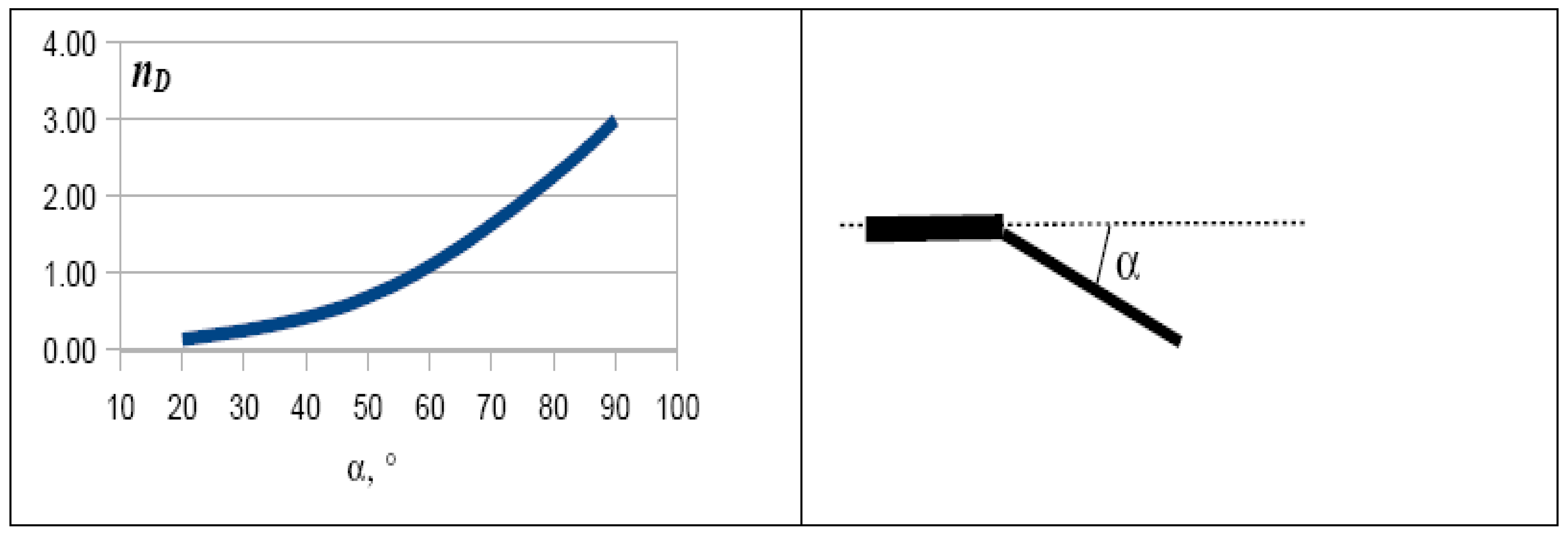
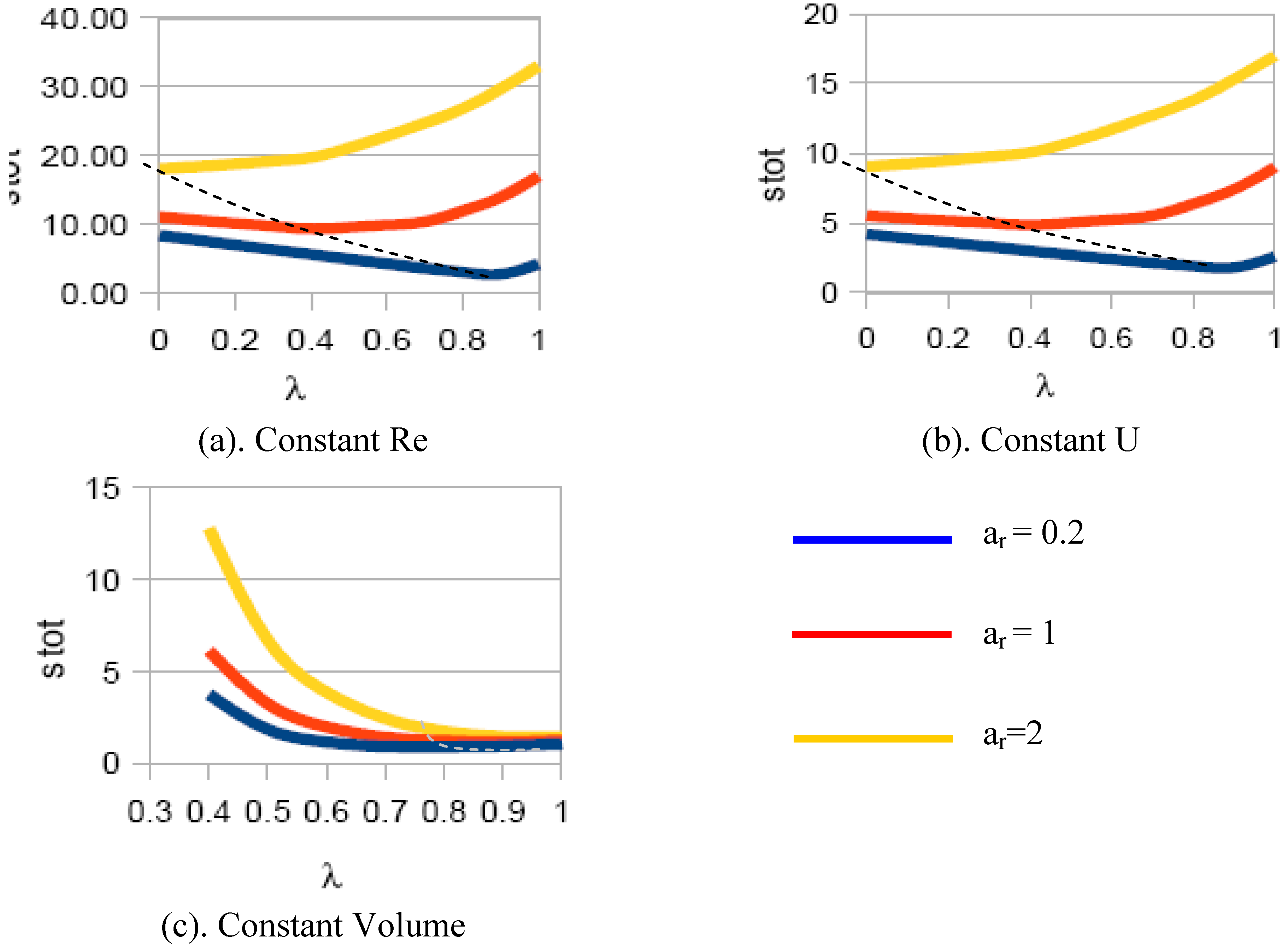
- (a)
- For all cases, the entropy generation rate displays a marked increase: for the same aspect ratio ar, same splitting length and same diameter ratio, the dissipation is increased of a factor between 1.5 and 4. This confirms the importance of real-flow effects on the optimal configuration;
- (b)
- For each physical situation (constant Re, constant U, constant Vfluid) there is still an “optimal” configuration that displays a minimum value of the entropy generation rate, but the minimum is markedly shifted towards lower splitting ratios (earlier bifurcation), except for the constant volume case, in which it is very near the “T” configuration (λ≈1). The exact values are reported in Table 2.
| Case: Re0 = Re1 | δ = r1/r0 | λ | Minimum |
| ar = 0.2 | 0.5 | 0.9 | 2.71 |
| ar = 1 | 0.5 | 0.4 | 9.81 |
| ar = 2 | 0.5 | 0 | 18.07 |
| Case: U0 = U1 | δ = r1/r0 | λ | Minimum |
| ar = 0.2 | 0.707 | 0.9 | 1.80 |
| ar = 1 | 0.707 | 0.4 | 4.85 |
| ar = 2 | 0.707 | 0 | 9.03 |
| Case: V0 = 2V1 | δ = r1/r0 | λ | Minimum |
| ar = 0.2 | 1.15 | 0.8 | 0.88 |
| ar = 1 | 1.36 | 0.9 | 1.14 |
| ar = 2 | 1.50 | 1 | 1.40 |
5. Conclusions
- (a)
- For all examined situations, a configuration exists that displays the lowest viscous entropy generation rate compatible with the imposed constraints;
- (b)
- In all cases, the diameter ratio δ can be derived from purely phenomenological considerations: there is no a priori optimal value for this parameter;
- (c)
- The entropy generation rate appears to be a consistent Lagrangian for the identification of the “optimal” configuration, and furthermore, the optima thus derived appear different from those suggested by both allometric and arithmetic/geometric models.
References
- Cano-Andrade, S.; Hernandez-Guerrero, A.; von Spakovsky, M.R.; Damian-Ascencio, C.E.; Rubio-Arana, J.C. Current density and polarization curves for radial flow field patterns applied to PEMFCs. Energy 2010, in press. [Google Scholar] [CrossRef]
- Escher, W.; Michel, B.; Poulikakos, D. Efficiency of optimized bifurcating tree-like and parallel microchannel networks in the cooling of electronics. Int. J. Heat Mass Transfer 2008, 07, 48. [Google Scholar] [CrossRef]
- Ramos-Alvarado, B.; Hernandez-Guerrero, A.; Juarez-Robles, D.; Li, P.; Rubio-Arana, J.C. Parametric study of a symmetric flow distributor. In Proceedings of ASME-IMECE, Lake Buena Vista, FL, USA, November 2009.
- Bejan, A. Entropy Generation Minimization; CRC Press: New York, NY, USA, 1995. [Google Scholar]
- Robbe, M.; Sciubba, E. A 2-D constructal configuration genetic optimization method. In Proceeding of ASME-IMECE, Boston, MA, USA, May 2008.
- Robbe, M.; Sciubba, E. Derivation of the optimal internal cooling geometry of a prismatic slab: Comparison of constructal and non-constructal geometries. Energy 2009, 34, 2167–2174. [Google Scholar] [CrossRef]
- Robbe, M.; Sciubba, E.; Bejan, A.; Lorente, S. Numerical analysis of a tree-shaped cooling structure for a 2-D slab: A validation of a “constructally optimal” configuration. In Proceedings of VIII ESDA-ASME Conference, Torino, Italy, July 2006.
- Sciubba, E. Do the Navier-Stokes equations admit a variational formulation? In Variational and Extremum Principles in Macroscopic Systems; Sieniutycz, S., Farkas, H., Eds.; Elsevier: Oxford, UK, 2004. [Google Scholar]
- Geskin, E.S. A variational principle for transport processes in continuous systems: Derivation and application. In Variational and Extremum Principles in Macroscopic Systems; Sieniutycz, S., Farkas, H., Eds.; Elsevier: Oxford, UK, 2004. [Google Scholar]
- Glansdorff, P.; Prigogine, I. On a general evolution criterion in macroscopic physics. Physica 1964, 30, 351–374. [Google Scholar] [CrossRef]
- Gyarmati, I. Non-Equilibrium Thermodynamics; Springer-Verlag: Berlin, Germany, 1970. [Google Scholar]
- Sieniutycz, S. Field variational principles for irreversible energy and mass transfer. In Variational and Extremum Principles in Macroscopic Systems; Sieniutycz, S., Farkas, H., Eds.; Elsevier: Oxford, UK, 2004. [Google Scholar]
- Hess, W.R. Das Prinzip des kleinsten Kraftverbrauches im Dienste hämodynamischer Forschung. Arch. Anat. Physiol. (Physiol. Abteil.) 1914, 1/2, 1–62. [Google Scholar]
- Murray, C.D. The physiological principle of minimum work: I. The vascular system and the cost of blood. Natl. Acad. Sci. 1926, 12, 207–214. [Google Scholar] [CrossRef]
- Rubio-Jimenez, C.A.; Hernandez-Guerrero, A.; Rubio-Arana, J.C.; Kandlinkar, S. Natural patterns applied to the design of microchannel heat sinks. In Proceedings of ASME-IMECE, Lake Buena Vista, Florida, USA, November 2009.
- Robbe, M. CFD Analysis of the Thermo-Fluidynamic Performance of Constructal Structures. Ph.D. Thesis, University of Roma 1, Rome, Italy, 2007. [Google Scholar]
- Bejan, A. Constructal-theory network of conducting paths for cooling a heat generating volume. Int. J. Heat Mass Transfer 1997, 40, 799–816. [Google Scholar] [CrossRef]
- Bejan, A. Shape and Structure from Engineering to Nature; Cambridge U. Press: Cambridge, UK, 2000. [Google Scholar]
- Bejan, A.; Rocha, L.A.O.; Lorente, S. Thermodynamic optimization of geometry: T- and Y-shaped constructs of fluids streams. Int. J. Therm. Sci. 2000, 39, 946–960. [Google Scholar] [CrossRef]
- Bejan, A.; Lorente, S. The constructal law and the thermodynamics of flow systems with configuration. Int. J. Heat Mass Transfer 2004, 47, 3203–3214. [Google Scholar] [CrossRef]
- Sciubba, E. Constructal theory & variational principles for the Navier-Stokes equations: Is there a link? In Proceedings of Workshop on Constructal Theory of the Generation of Optimal Flow Configuration, Rome, Italy, March 2005.
© 2010 by the authors; licensee MDPI, Basel, Switzerland. This article is an Open Access article distributed under the terms and conditions of the Creative Commons Attribution license (http://creativecommons.org/licenses/by/3.0/).
Share and Cite
Sciubba, E. Entropy Generation Minima in Different Configurations of the Branching of a Fluid-Carrying Pipe in Laminar Isothermal Flow. Entropy 2010, 12, 1855-1866. https://doi.org/10.3390/e12081855
Sciubba E. Entropy Generation Minima in Different Configurations of the Branching of a Fluid-Carrying Pipe in Laminar Isothermal Flow. Entropy. 2010; 12(8):1855-1866. https://doi.org/10.3390/e12081855
Chicago/Turabian StyleSciubba, Enrico. 2010. "Entropy Generation Minima in Different Configurations of the Branching of a Fluid-Carrying Pipe in Laminar Isothermal Flow" Entropy 12, no. 8: 1855-1866. https://doi.org/10.3390/e12081855
APA StyleSciubba, E. (2010). Entropy Generation Minima in Different Configurations of the Branching of a Fluid-Carrying Pipe in Laminar Isothermal Flow. Entropy, 12(8), 1855-1866. https://doi.org/10.3390/e12081855




